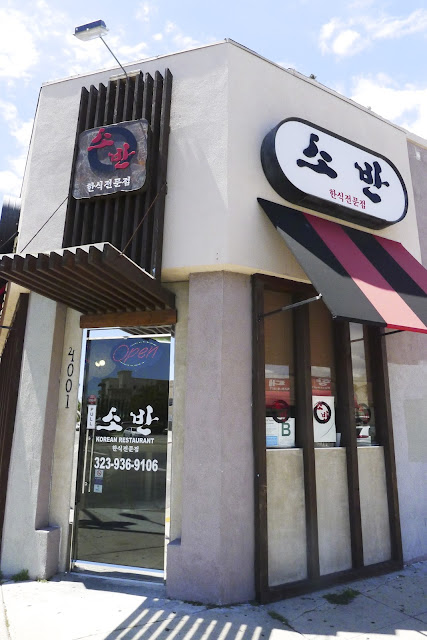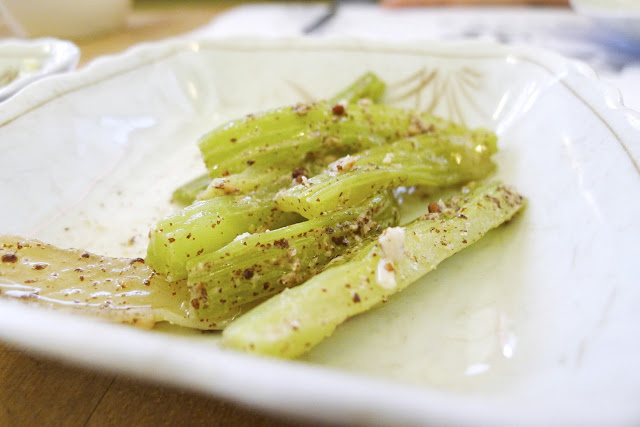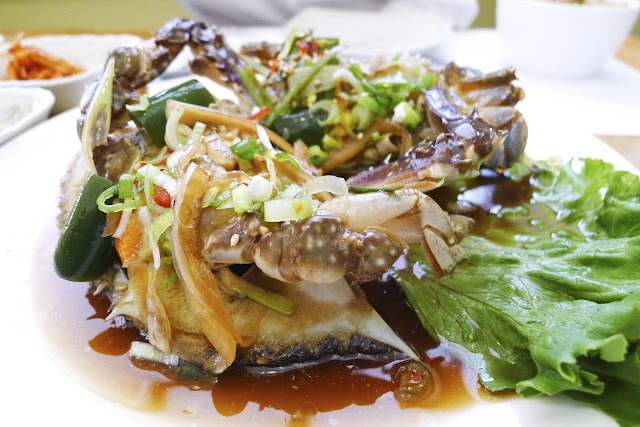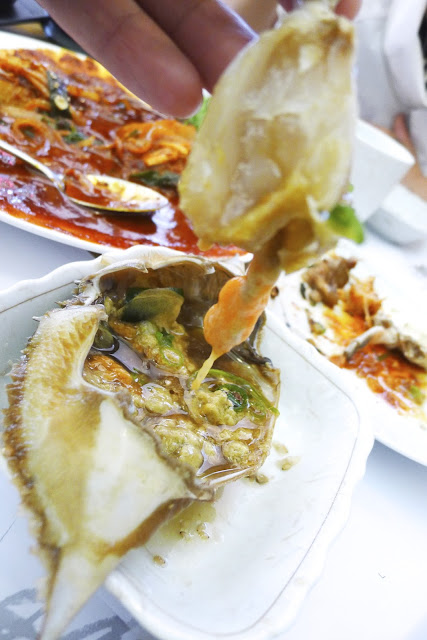Apologies for the delay in posting. Searching for a job/apartment/car, as well as a couple weddings, has really put me back. But I think I'm getting into the groove of things again, so let's just pick up where we left off, like a couple of old friends.
Next to Mexicali Taco & Co., Soban is the only other place I make a point of going to on every trip back to L.A. And like Mexicali, Soban has found a way to nestle its way into my soul, almost to the point where writing about it is absolute torture. But with the hunger pangs still fresh from writing about Mexicali, I figured I should just push through this one as well.
A soban is a low, wooden table typically used for family eating, and the name for this restaurant could not be more appropriate. When you eat here, you're either eating with family, or it sure as hell feels like it. The food here is, at its heart, comforting. It's food that you feel in your gut, that makes your eyes roll back, that gives your spine a tingle, and that makes a single tear roll down your cheek. As if that weren't enough, Soban's food often shocks your tongue to life, elevating familiar flavors by just enough to leave you excited to eat more.
Service is almost always fast, attentive, and friendly, even when they're slammed and in the zone. Lots of dishes come with some tableside service, which can be fun for first-timers.
Like a well-stocked Korean home refrigerator, every meal starts with anywhere from 12 to 15 banchan plates.
Most of them are staples, but a few are unique to Soban. Even with the staples, Soban does them better, as if to say, "Why do a dried out piece of egg when you can do a silkier, more delicate version?" Thankfully, my favorites are almost always in the set.
For me, the Deulggae (wild sesame) (also, romanizing Korean is a ridiculous venture) Seasoned Celery goes down the hatch in a matter of seconds. Perfectly blanched celery with just enough preserved crisp and give. Each bite is cool and refreshing, but also a little sweet and nutty.
The Seasoned Parsley is my second favorite. It uses classic Korean seasoning techniques, but with a non-traditional vegetable. The result is a very herbal, cleaner, and punchier version of a typical Korean Seasoned Spinach.
And as if the banchan spread wasn't enough, you also get your choice of either white rice or jakgok rice. I almost always go for the jakgok rice because of its more complex and often more satisfying flavor, complete with a mix of beans and chestnuts. But I understand that sometimes white rice is just too darn good to pass up.
Before we get to my absolute favorites, let's look at some of Soban's other stellar offerings. The Haemul Dooboo Jun can be a full meal on its own. It's a hefty, crisp, and satisfying plate of three to four seafood tofu pancakes packed with the flavor of sesame seeds and green onion. The amount of toothsome octopus and squid is just right, and the accompanying sauce adds a salty and citric touch.
The Dwenjang Jjigae is one of the best I've had in L.A. My mom makes a mean dwenjang jjigae, so I can't give this fermented soy bean stew too much praise, but I will say that it's the best I've had in a restaurant outside of Korea and my parents' home. Comforting, savory, rich, and refreshing, this stew hits all the right notes on a rainy day.
The Saengtae Tang is an exceptional pollock stew with a beautiful, delicate broth. My mom doesn't really like adding anything spicy to saengtae tang, and that's what I grew up with, so I always get this without the default addition of red chili powder. The stew is huge, packed with a colorful mix of squash, onions, and other vegetables, generous portions of tofu, and a perfectly-cooked body of a pollock. The fish meat flakes at the touch of a fork and its subdued flavor lends itself to rounding out a clean and refreshing stew. If you see some strange-looking intestinal things floating in your stew, don't say anything and just pop it in your mouth. You might be pleasantly surprised.
Now let's get to the outrageously exceptional stuff. First up, the Hanchi Moolhwae, a shocking display of sliced radish and noodles made out of cuttlefish, topped with abalone, and flanked by tobiko, squid ink tobiko, and green sprouts. Sometimes they throw in some julienned Asian pear, too.
Depending on how spicy you want it to be, someone will pour on a gochu jang (red chili paste) and rice vinegar based sauce that tastes like it has some oysters or something ocean-based mixed into it. I usually go with half-spicy or less, just because I'm afraid that too much spice will take away from the freshness of the abalone and cuttlefish. It would probably be really tasty on its own or on some rice, but refrain, and let the process continue.
Next, they'll ask if you want some ice water to pour into your bowl. I know, it sounds weird, but just let them do their thing.
The result is unforgettable. Toothsome and refreshing cuttlefish noodles, crunchy and flavorful bits of abalone, crisp strands of radish, sharp and brief notes of green sprouts, and addictive bursts of tobiko. The ice water essentially becomes a cool soup laced with the chili-vinegar sauce. If you're still full after all the noodles, throw in a bowl of rice (preferably white, in this case) into the soup and enjoy.
Next up, the Galbi Jjim. Now, I think I've said before how every Korean kid claims their mom has the best rendition of this dish, but this is the closest any restaurant has gotten to getting me to say that it's as good as my mom's. Sweet, succulent gems of perfectly braised short rib, swimming in an addictive pool of a sweet and salty sauce and accompanied by pine nuts, dates, strips of orange rinds, and delicate strands of egg.
Like the Saengtae Tang, I prefer this dish without the optional spice, but I will say that the spice is a great way to cut through some of the sweetness. Both are incredible, so get on it. And either way, get some rice on your spoon and dip it into the braising sauce. So, so good.
The third of my four staples is their Eundaegu Jorim. I am a sucker for this dish. If it's on a menu at any Korean restaurant, I immediately want to get it. Something about it speaks to me, and over a bowl of rice, it's a killer.
Like everything else I've tried at Soban, the Eundagu Jorim here is objectively better. The black cod is perfect: silky, supple, buttery, and flaky. The braising sauce is just sweet enough with just the right amount of spice. Usually, I don't go for the spice (if you haven't noticed already), but this is the exception. The vegetables and tofu, like those in the Galbi Jjim, are infused with the addictive braising sauce. And also like the Galbi Jjim braising sauce, taking a spoon of rice and dunking it in the braising sauce is obligatory.
Before I continue, I have to give a shout out to Steph C., who essentially put this place on the map. But I have to attribute credit to my mom for finding out that Soban's specialty is their Ganjang Gaejang, my fourth and final staple.
A literal description of what this is just doesn't do it justice. I mean, really, when did marinating raw crab and slurping it out of its shell ever sound appealing? SINCE FOREVER.
With a smell brimming on the edge of musky East Asian medicine, a cold plate arrives with two crabs, split in quarters or halves, relaxing in a pool of delicious, briny marinating juices. Don't be intimidated by the loose, slippery texture. Just go for it.
For those who are unfamiliar with how to eat the stuff, proceed as follows:
(1) Pick up a quarter with your fingers.
(2) Take a second to marvel at the beautiful, shiny gem of a morsel you are about to eat. I mean, look at those eggs!
(3) Pick it back up and suck. Yum. At this point, you should be tasting the ocean, along with some ginger and ginseng, a little spice, just a touch of vinegar, and a sweetness similar to an herbal date.
(4) Depending on how much you love what you're tasting, continue sucking until you get every last bit of that translucent crab meat.
(5) Continue until only the crab's carapace remains with all of its guts and glorious juices.
(6) Get some rice in that business and mix it up.
(7) Enjoy.
(8) Scrape every bit of amazingness.
(9) You've probably guessed this by now, but take whatever rice you have left and dip a spoonful into the marinating juices. So, so, so good.
(10) Let the single tear roll down your face as the plate is cleared from your table.
(11) Maddeningly attempt to get the smell of Ganjang Gaejang off of your fingers.
(12) Revert to unabashedly smelling your fingers as another single tear rolls down your face.
(13) Look longingly at the unadulterated plates of Ganjang Gaejang arriving at other tables.
(14) Hiss at the other tables.
(15) Make a creepy grimace until the other tables get uncomfortable.
(16) You should have stopped reading this by now.
Every meal ends with one of my favorite renditions of Shikhae. My biggest problem with most is that they're either too watery, too sweet, or both. But this. Just enough sweetness and just enough horchata-like texture to make this a wonderfully refreshing way to end the meal.
Despite having gone to Soban over a dozen times now, there's a lot on the menu that I haven't tried. Probably because I only get to go to Soban once every time I go to L.A. And probably because the dishes I always make a point to get are just too absurdly delicious. Oh well. Next time, I say, next time.
Soban
4001 W Olympic Blvd
Los Angeles, CA 90019
(323) 936-9106
http://www.sobanusa.com/
GET: Ganjang Gaejang; Galbi Jjim; Eundaegu Jorim; Hanchi Moolhwae.





























